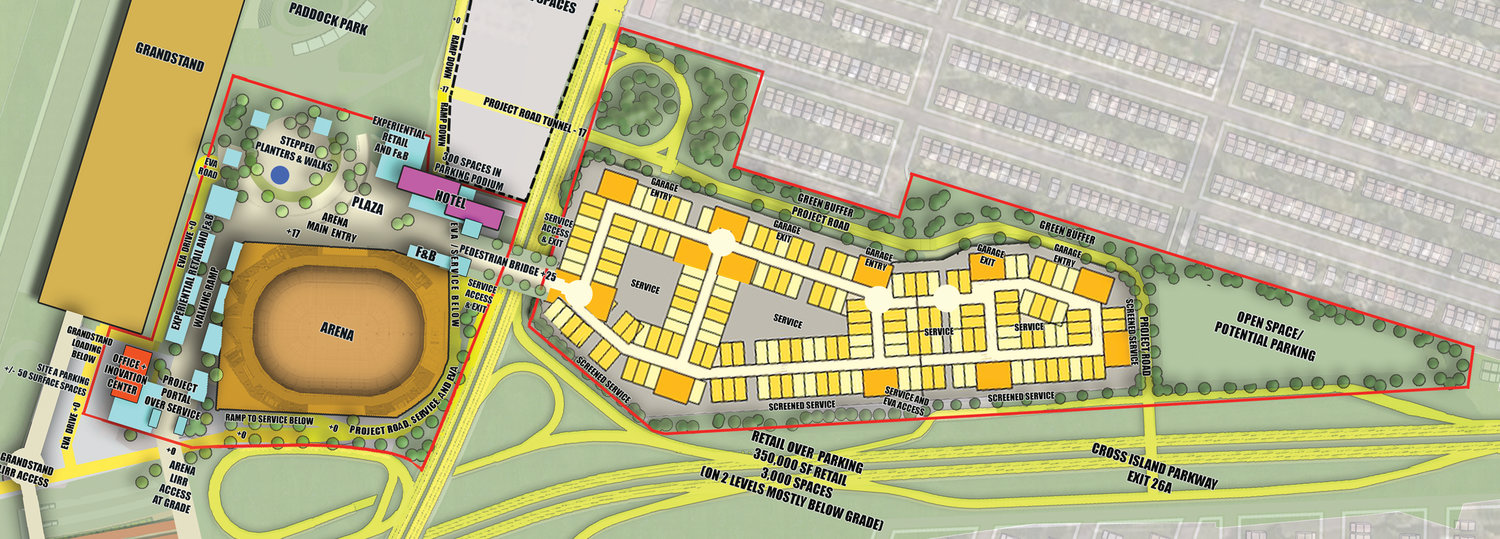NYC looks into Belmont
City to analyze traffic impacts of arena project
Ever since Empire State Development released its Draft Environmental Impact Study in December, several groups in Elmont and Floral Park have raised concerns about the proposed Belmont arena project. Construction on it is set to begin this spring.
On Dec. 17, New York City joined the conversation as city Comptroller Scott Stringer and Council member Barry Grodenchik wrote a letter to the city’s Department of Transportation, expressing their worries that the Belmont project could have severe adverse effects on the roads near the Queens-Nassau County border.
In the letter, Stringer noted that six intersections along Hempstead Avenue in Queens were cited as areas that could see heavier traffic because of the project, and both he and Grodenchik said ESD should have further studied the situation in eastern Queens.
“Not only are these six intersections insufficient to gauge the impact of this project on Queens neighborhoods,” Stringer wrote, “they are also largely under the jurisdiction of [the city’s] DOT, not the state.”
The department was studying Jamaica and Hempstead avenues as part of its Nassau/Queens Interface Transportation Study, and a spokesperson said that the city would be adjusting its scope to incorporate the additional intersections and concerns raised by Stringer. ESD spokesman Jack Sterne said the agency was already in touch with the city’s DOT to review the affected streets.
“We look forward to working with all members of the community to develop a plan that provides the most appropriate mitigation for the impacts identified in the DEIS and contributes to the success of this transformative project,” Sterne said.
As previously reported by the Herald, after the Draft Environmental Impact Study was released, county and town roads could be significantly impacted by the arena project, as well.
In its study, ESD had planned to channel most of the traffic that would be generated from the arena onto Hempstead Turnpike and the Cross Island Parkway, which is under the state’s jurisdiction. But the agency recognized that drivers using GPS apps to bypass the traffic on these routes might use local roads as shortcuts. “One such diversion route may include Elmont Road,” the impact study read, “which could be used by vehicles in the northbound direction originating from the eastbound Belt Parkway or the westbound Southern State Parkway in the event that there is congestion on the northbound Cross Island Parkway.”
With ESD projecting nearly 6,000 more vehicles traveling through Elmont and Queens during peak hours at the arena, it concluded that the Cross Island Parkway could process between 74 to 100 percent of the traffic, and estimated that about 1,600 vehicles would likely be “unserved” by the thoroughfare, leading to traffic backing up or those vehicles finding alternate routes to Belmont.
Tammie Williams, of the Belmont Park Community Coalition, said she was worried that congestion on the Cross Island Parkway and “unserved vehicles” would send too many cars onto local roads. “The project will choke southeast Queens in addition to Elmont and Floral Park,” Williams said.
The coalition has also repeatedly asked that ESD look at the possible traffic effects on Dutch Broadway, which could also be used as a shortcut to Elmont Road from the Southern State Parkway. Dutch Broadway has long been plagued by accidents, and the Nassau County Department of Public Works is currently conducting a traffic study of the area to implement safety measures. Nassau officials have not responded to the Herald’s requests on whether it will follow suit with New York City and incorporate the arena’s possible impact on Elmont’s local streets into its own study.
Floral Park officials and residents are also increasingly worried about their roads being used as shortcuts, especially on Plainfield Avenue, which was cited in the study as a possible problem area. Floral Park Deputy Mayor Kevin Fitzgerald said that traffic would only get worse in Floral Park. With the Long Island Rail Road’s Third Track project moving forward with construction in the area, and other street maintenance projects beginning at the south side of Floral Park near Elmont, Fitzgerald described a traffic nightmare that could grow over time.
Kevin Flood, vice president of Floral Park’s West End Civics, said the scope and impact of the Belmont Arena is affecting an ever-increasing swath of the community. Flood, a lifelong Floral Park resident, said that his community was not prepared to handle all the traffic from the arena.
“I keep hearing ESD saying that there’s tremendous support for the arena in local communities, but that’s not the case here,” Flood said.







